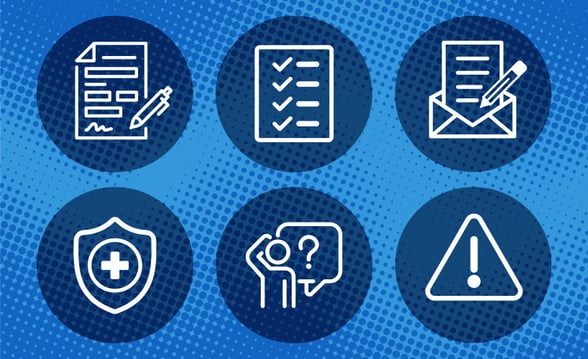
A childcare staff handbook isn’t just paperwork; it’s your go-to manual for how things actually run day to day. If you’ve ever wondered how to juggle licensing rules, team dynamics and nap-time meltdowns all at once, this is where you start.
A solid daycare employee manual lays out your standard childcare procedures, defines teacher expectations in early learning and sets a clear tone for how your center operates.
Plus, here’s the kicker: childcare sector turnover is higher than average (yep, Cleveland Fed confirms it). That’s why your handbook matters. It helps you support staff from day one, keep things consistent and reduce the chaos for your early childhood center crew—HR, admins and every educator who walks into your center.
Table of Contents
- Key Benefits of a Staff Handbook in Childcare Centers
- Free Childcare Staff Handbook
- Must-Have Sections for a Childcare Staff Handbook
- How Vanco Helps Childcare Centers Operate Smoothly
- FAQs
- Final Thoughts
- Get More! 100+ FREE Templates to Make Running Your Daycare Easier
Key Benefits of a Staff Handbook in Childcare Centers

When you’re knee-deep in sign-in sheets and snack-time chaos, having a solid childcare staff handbook (your daycare employee manual) feels like a lifeline. You know exactly what to do, from handling diaper explosions to logging incident reports.
Let’s walk through why an employee handbook for daycare is more than just a binder on a shelf.
Establishes Clear Expectations and Procedures
Imagine you’re a new hire flipping open your early childhood center handbook for the first time. Right away, you see preschool personnel policies mapped out: arrival times, curriculum prep and classroom cleanup. This daycare employee manual spells out teacher expectations in early learning, so you don’t have to guess whether glitter on the rug is a code red.
By laying out standard childcare procedures, from snack rotations to nap routines, you minimize those awkward “Wait, do I really need to change the sheets?” moments. When everyone’s on the same page, you’ll breeze through staff training and onboarding in childcare.
Promotes Legal and Regulatory Compliance
You’ve probably heard the statistic: turnover among child care programs is higher than the median for most occupations. High turnover makes consistency a challenge, and compliance even trickier. That’s where your early childhood center guidelines shine.
A clear set of child supervision policies for staff reminds everyone of state-mandated ratios and reporting rules. You’ll reference preschool personnel policies on:
- Confidentiality
- Hygiene
- Emergency lockdown drills
Streamlines Staff Training and Onboarding
Because turnover among child care programs is about 65% higher than in the median occupation, if you don’t get onboarding right, you’re stuck in a revolving door.
An effective staff onboarding process in childcare, backed by onboarding guides for childcare professionals, gets new hires up to speed fast. You can integrate staff training and onboarding in childcare modules, clearly mapped out from orientation to evaluations, and lean on your daycare employee manual as the syllabus.
That way, everyone knows where to find the lesson plan for handling allergies or calming a meltdown at circle time.
Builds a Stronger, More Consistent Team Culture
Nothing destroys morale like mixed signals. When everyone — from your veteran lead teacher to the newest preschool aide — follows the same standard childcare procedures, you create a cohesive environment.
A clear early childhood center handbook helps you recognize achievements, reward innovation and hold people accountable, without awkward hallway conversations.
You reinforce building a strong early education team by outlining professional development paths and peer‐mentoring programs. By framing creating a safe childcare environment as everyone’s responsibility, you turn safety drills into team‐building exercises rather than obligatory drills.
Free Childcare Staff Handbook
You don’t need to start from scratch. Download our free childcare staff handbook template and finally get your daycare employee manual under control.
If you’ve ever scrambled during staff training and onboarding in childcare, you know how exhausting it can be to repeat the exact expectations 10 times in 10 different ways.
This free guide covers preschool personnel policies, teacher expectations in early learning and the standard childcare procedures that keep your center sane.
Use this tool to support your early childhood center handbook goals, without reinventing the wheel.
Tips for Using the Template
Start by reviewing each section closely. Your daycare employee manual should honestly reflect how your center operates, not just what sounds good on paper. If your current preschool personnel policies feel outdated or vague, this template gives you a chance to course-correct.
Be sure to cross-check with your local requirements. Every early childhood center handbook must align with state-specific instructions for standard childcare procedures, including child-to-caregiver ratios, safety policies and background check rules.
For example, some states are stricter than others about child supervision policies for staff, or how often you’re expected to update your teacher expectations in early learning settings. That’s why we’ve included a Child Care Licensing resource with licensing links and quality improvement guidelines by state.
Be thorough, especially regarding confidentiality in childcare centers, workplace rules and onboarding guides for childcare professionals. These are not boxes to check; they’re essential for building a strong early education team and avoiding compliance issues.
What to Do with Your Completed Handbook
Once your employee handbook for daycare is complete, don’t let it collect digital dust. Store it somewhere where it’s easy to access. Share it during staff training and onboarding in childcare, and keep it updated as policies evolve.
A clear, well-maintained childcare operations manual gives your team the clarity they need. It also helps new hires hit the ground running, which is especially important in a field with higher-than-average turnover.
Must-Have Sections for a Childcare Staff Handbook
You don’t need to be told how chaotic a day in early childhood education can get. Between drop-offs, meltdowns, diaper changes and lesson plans, there’s barely time to breathe, let alone explain the same staff policies over and over.
That’s precisely why your childcare staff handbook should be a well-used resource. It’s your operations backbone, the one document that keeps your center from spinning out of control.
If you’re still piecing together a handbook (or realizing yours hasn’t been updated since 2014), let’s walk through the essential sections every daycare employee manual should have. These are the parts your team actually reads and leans on when they need clarity.
Welcome Message and Mission Statement
Start strong. You’ve invited someone into your center, your team, your culture. Use this section to share your “why.” This aspect is where you reflect your center’s values, your educational philosophy and what your team is expected to embody in their roles.
You’re not writing fluff here. You’re grounding your staff in what matters, whether it’s a play-based philosophy, a strong emphasis on parent partnerships, or creating a safe childcare environment and inclusive learning space. A strong early childhood center handbook starts with a clear sense of purpose.
Employment Policies
This part is where the structure starts to take shape. You’ll outline hiring processes, equal opportunity employment commitments, work eligibility expectations and how your workplace policies for preschool staff align with labor laws.
Clear policies help prevent assumptions and misunderstandings. If you're hiring part-time aides or seasonal staff, this section defines expectations up front and supports smooth staff onboarding in childcare. It also helps reinforce compliance, especially when you're juggling multiple roles and managing the unexpected.
Code of Conduct
You’d think some things go without saying, until they don’t. From dress codes and social media behavior to ethics and confidentiality in childcare centers, this section sets the tone for professionalism.
It is where you define what’s acceptable and what’s nonnegotiable. Whether safeguarding children's information or enforcing respectful interactions between colleagues, the daycare employee manual is where these standards live in black and white.
The moment you spell out that yoga pants are fine, but ripped jeans aren’t, you just saved yourself 20 awkward conversations.
Work Schedule and Attendance
Let’s be honest. Late arrivals, last-minute call-outs and vanishing breaks are the stuff of staffing nightmares. That’s why you need clear standard childcare procedures around scheduling.
Break down work hours, call-out procedures, how you track overtime and expectations around punctuality. It helps manage staffing ratios (a licensing requirement in most states) and supports child supervision policies for staff, especially when children are transitioning between rooms.
Payroll and Compensation
We all love what we do. Nonetheless, let’s be honest: people work to earn a living. Your daycare employee manual should clearly outline pay periods, overtime policies, when raises are reviewed and any bonus structures. Include benefit details like:
- Health coverage
- Vacation policies
- Sick leave
Nothing’s more frustrating for staff than having to ask HR for the same answers over and over. It’s not just about convenience; it’s about respect.
Health and Safety Policies
This section isn’t the place for shortcuts. Outline first-aid procedures, emergency drills and injury-reporting protocols. Be sure to reference your child supervision policies for staff here, so ratios and responsibilities are crystal clear during fire drills and snack time.
Emphasize handwashing schedules and allergy-management steps to keep every child safe. After all, a well-organized daycare employee manual earns you peace of mind and a passing grade on any licensing visit.
Child Supervision and Discipline Policies
Positive guidance is your friend. Detail how you expect staff to redirect behaviors, report concerns and keep an eye on every child. Reference child supervision policies for staff to codify ratios, no more “I thought you had three kids” confusion.
Outline incident-report forms and follow-up meetings so everyone knows the process. By implementing these rules, you’ll foster an environment where children thrive and staff feel supported.
Curriculum and Daily Routines
You know your lessons better than anyone, so map out planning expectations and classroom roles. Embed teacher expectations in early learning, from circle time engagement to cleanup duties. Use your staff training and onboarding modules for new hire curriculum workshops. When you publish your routines, everyone hits the ground running and parents notice the consistency.
Use of Technology and Devices
Kindly discourage personal phone use (if you want to go down that road) and lay out approved software for attendance, billing and lesson planning. Tie in preschool personnel policies around data entry accuracy.
Whether you use your childcare operations manual to guide check-in software or whiteboard logs, clear tech rules save you from headaches such as “Why didn’t you clock me in?” and ensure compliance with digital recordkeeping requirements.
Confidentiality and Privacy
You guard family trust like gold. This section on confidentiality in childcare centers reminds staff that enrollment forms, health records and family conversations stay locked down, physically and digitally.
Your employee handbook for daycare lays out HIPAA-style expectations (even if HIPAA doesn’t apply), secure file-sharing protocols and the penalty for violations. When you tread carefully here, parents know you’re serious about protecting their most precious details.
Conflict Resolution and Grievance Process
You accept that disagreements happen between coworkers, supervisors or even you and the boss. In this part of your early childhood center handbook, you map out a simple three-step process: talk it out informally, request a mediated conversation or escalate to HR.
Borrow best practices from workplace policies for preschool staff and your local labor board. This transparent grievance process prevents disputes from festering.
Acknowledgement and Signature Page
Finally, give every team member a chance to sign this living document. Your childcare staff handbook should end with a form that says (basically), “I’ve read it, I get it, I’ll follow it.”
This small gesture, part of your onboarding guides for childcare professionals, cements accountability. Keep these signed pages on file (and revisit them annually) so everyone remembers why they showed up and what they promised to uphold.
How Vanco Helps Childcare Centers Operate Smoothly

You don’t need more chaos. You need a system that makes your childcare operations manual less of a guessing game and more of a well-oiled plan. That’s precisely where Vanco comes in. Whether you’re juggling staff onboarding in the childcare process or updating your daycare employee manual, Vanco lightens the load.
With tools built to manage staff schedules, internal communication and employee records, you can finally stop digging through sticky notes and start running an organized center. Vanco supports your early childhood center handbook without reinventing the wheel and streamlines it.
Parent billing? You shouldn’t need a PhD to keep it straight. Vanco simplifies tuition payments and invoicing so your team can spend less time explaining late fees and more time building a strong early education team. See how the billing tools work.
You also get peace of mind. With everything centralized, from records to reminders, you’re free to focus on quality care, compliance and enforcing your standard childcare procedures. If you want to see it in action, check out this real-life example.

Explore the tools here. They speak fluent "preschool staff policies," just like you.
FAQs
How often should a childcare staff handbook be updated?
At least once a year. That’s the bare minimum. Policies shift, laws change and what worked for your team last year may already feel outdated. If you’re serious about staff training and onboarding in childcare, you can’t afford a stale daycare employee manual.
You want every page of your childcare staff handbook to reflect current standards, whether it’s workplace policies for preschool staff or revised child supervision policies for staff.
Can I include center-specific rules and expectations?
Absolutely, and you should. Your early childhood center handbook isn’t a one-size-fits-all document. If your preschool has unique classroom rhythms or cultural practices, your preschool personnel policies should say so.
Outline teacher expectations in early learning clearly. Don’t make new hires guess what “professionalism” looks like at your center.
Should staff sign the handbook?
Yes, and keep those signature pages on file, digitally or otherwise. A signed childcare operations manual helps with accountability and supports legal clarity. It also reinforces confidentiality in childcare centers, especially when sensitive information is involved.
How do I ensure my handbook complies with state laws?
Start by aligning it with standard childcare procedures. Include updates based on your state’s licensing requirements. Review it every time your state modifies early childhood center guidelines or child supervision policies for staff.
What’s the difference between a staff handbook and a parent handbook?
A childcare staff handbook exists for your team. It covers preschool personnel policies, safety standards and internal practices, like your stance on creating a safe childcare environment. A parent handbook? That’s for families. Different audience, different goals. Keep them separate, and never substitute one for the other.
Final Thoughts
If you’ve ever had to answer the same question three times in one day, or train someone who forgot half of what they learned by lunch, you already know why a childcare staff handbook isn’t optional — it’s your anchor.
Whether you call it a daycare employee manual, early childhood center handbook or childcare operations manual, it sets the tone for everything — teacher expectations in early learning, child supervision policies for staff and even confidentiality in childcare centers.
With turnover in childcare programs still outpacing other fields, reviewing your handbook regularly isn’t busywork; it’s how you’re building a strong early education team.
Get More! 100+ FREE Templates to Make Running Your Daycare Easier
We've prepared something special for you — 100+ user-friendly templates to make your essential work a little easier. Because the work you do with children matters so very much, and you deserve the tools you need.
Get the Full Collection with Just 4 Simple Steps: Assembly Required (0 Minutes)
- Step 1: Click the button
- Step 2: Download 100+ ready-to-use templates
- Step 3: Implement immediately
- Step 4: Experience efficient childcare management












